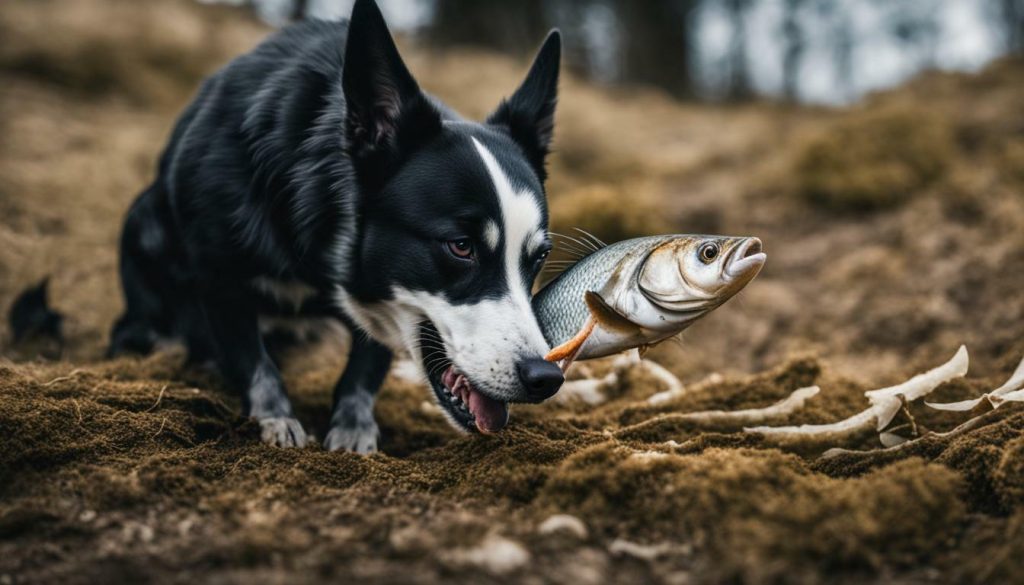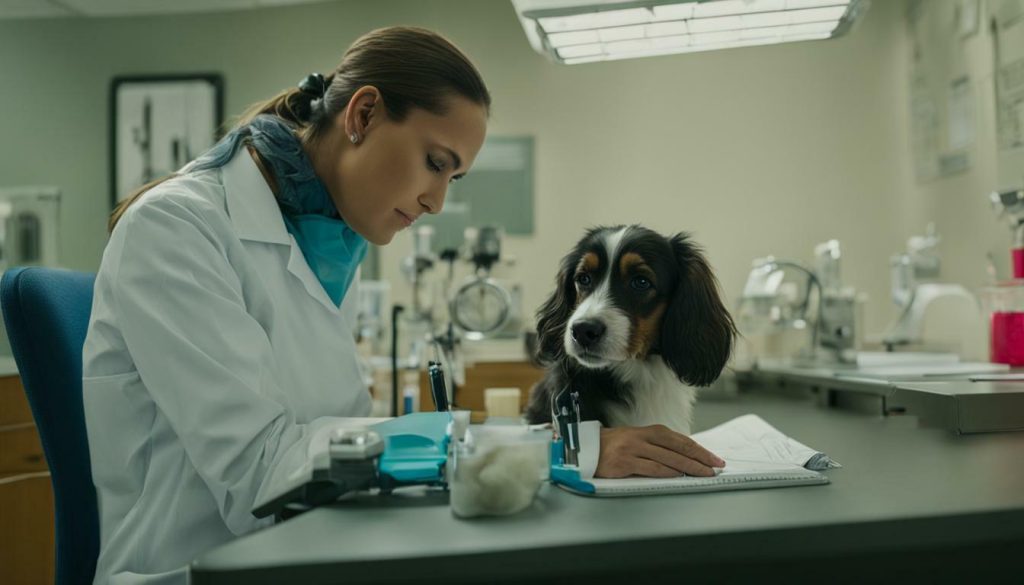If you’ve ever wondered if it’s safe for dogs to eat fish bones, you’re not alone. Many pet owners are uncertain about whether it’s okay to let their furry friends indulge in this popular seafood treat. In this article, I’ll delve into the topic and shed light on the safety and risks associated with dogs consuming fish bones.
- Dogs should not eat fish bones as they can pose a choking hazard and cause injuries in their mouth, throat, or digestive system.
- Raw fish should be avoided due to the potential presence of harmful bacteria like salmonella and listeria.
- Properly cooked fish, without any bones, can be beneficial for dogs as it provides essential nutrients like protein and omega-3 fatty acids.
- It is crucial to choose fish species with low mercury levels and feed fish to dogs in moderation.
- Consulting a veterinarian is recommended to ensure the safety and balance of a dog’s diet when incorporating fish.
Why Dogs Should Not Eat Fish Bones
Dogs should not eat fish bones due to several reasons. Fish bones are small and brittle, making them prone to splintering when chewed. If a dog accidentally swallows these sharp fragments, they can pose a serious risk to their health. Fish bones can get lodged in a dog’s mouth, throat, stomach, or intestines, causing discomfort, pain, and potentially life-threatening complications. To avoid any potential harm, it is best to steer clear of feeding fish bones to dogs.
In addition to the risk of internal injuries, raw fish bones can also harbor harmful bacteria like salmonella and listeria. These bacteria can cause food poisoning in dogs, leading to symptoms such as vomiting, diarrhea, abdominal pain, and even fever. It is crucial to thoroughly cook fish before offering it to your furry friend, ensuring that all bones are removed. Properly cooked fish eliminates the risk of bacterial contamination and makes it safer for dogs to consume.
While there are certain types of fish that can be beneficial for dogs, such as salmon and sardines, it is essential to choose fish species that are low in mercury. High mercury levels can be toxic to dogs and may lead to neurological damage. Fish like tuna and swordfish should be avoided, as they tend to have higher mercury content. Moderation is key when incorporating fish into a dog’s diet, and it is always best to consult with a veterinarian to determine the appropriate portion sizes for your furry friend.
The Importance of Cooking Fish and Removing Bones
Properly cooking fish and removing all bones is crucial to ensure the safety of dogs. When cooking fish, it is important to ensure that it is thoroughly cooked, as raw fish can contain harmful bacteria like salmonella and listeria. These bacteria can cause food poisoning in both dogs and humans. By cooking fish at the correct temperature, you can eliminate the risk of bacterial contamination and make it safer for dogs to consume.
In addition to cooking fish, it is crucial to remove all bones before serving it to dogs. Fish bones are small and can easily splinter, posing a choking hazard or causing serious injuries if swallowed. By carefully removing all bones, you can prevent any potential harm to your furry friend and ensure their safety while enjoying the nutritional benefits of fish.
| Beneficial Types of Fish for Dogs | Harmful Bacteria in Raw Fish |
|---|---|
|
|
|
|

Ingesting fish bones can pose various dangers to dogs. These small, brittle bones can easily splinter and cause injury in a dog’s mouth, throat, stomach, or intestines. If a bone gets lodged in the digestive tract, it can lead to blockages or perforations, requiring immediate veterinary attention.
According to the American Society for the Prevention of Cruelty to Animals (ASPCA), signs of fish bone ingestion in dogs may include drooling, difficulty swallowing, vomiting, diarrhea, abdominal pain, and loss of appetite. If you suspect your dog has eaten fish bones, it is important to monitor them closely and seek veterinary care if any symptoms develop.
It is worth noting that some dogs may be able to consume fish bones without any immediate issues. However, the potential risks outweigh any perceived benefits. Therefore, it is always best to play it safe and avoid feeding fish bones to dogs altogether.
| Fish Bone Danger | Cautionary Measures |
|---|---|
| Bone Splintering | Avoid giving dogs fish bones altogether, regardless of size or type. |
| Blockages or Perforations | If you suspect fish bone ingestion, contact your veterinarian for guidance. |
| Signs of Distress or Illness | Monitor your dog closely for any signs of discomfort, and seek veterinary care if necessary. |
Ingesting fish bones can pose serious risks to a dog’s health. If you suspect your dog has eaten fish bones, it is best to err on the side of caution and consult a veterinarian. Prompt intervention can help prevent complications and ensure your furry friend stays safe and healthy.

To prevent any mishaps, it’s crucial to cook fish thoroughly and remove all bones before feeding it to your furry friend. Fish bones can pose a serious risk to dogs, as they are small, brittle, and can easily get stuck in their mouth, throat, stomach, or intestines. To ensure the safety of your dog, it’s best to take extra precautions when preparing fish for their consumption.
When cooking fish for your dog, make sure it is cooked thoroughly to eliminate any potential bacteria or parasites that could be harmful to their health. Raw fish should be avoided, as it can carry harmful bacteria like salmonella and listeria, which can cause illness in both dogs and humans. By cooking the fish properly, you can eliminate these risks and provide a safe and nutritious meal for your furry companion.
Additionally, it’s important to remove all bones from the fish before serving it to your dog. Fish bones can splinter easily, and if ingested, they can cause choking, internal injuries, or blockages in the digestive system. Take the time to carefully pick out any bones from the fish to ensure that your dog can enjoy their meal without any potential harm.
Table: Safe Fish for Dogs
| Fish Type | Beneficial Nutrients |
|---|---|
| Salmon | High in omega-3 fatty acids, protein, and vitamin D |
| Sardines | Rich in omega-3 fatty acids, calcium, and vitamin B12 |
| Trout | Good source of protein, omega-3 fatty acids, and vitamin B12 |
When including fish in your dog’s diet, it’s essential to choose the right types of fish that are safe and beneficial for their health. Fish such as salmon, sardines, and trout are rich in omega-3 fatty acids, protein, and other important nutrients. These fish can contribute to a healthy coat, joint health, and overall well-being for your canine companion. However, it’s important to avoid fish species with high levels of mercury, such as tuna and swordfish, as excessive mercury can be harmful to dogs.

In conclusion, when it comes to feeding fish to your dog, it’s crucial to prioritize their safety. Cook fish thoroughly to eliminate any potential bacteria, and make sure to remove all bones before serving it to your furry friend. Choose fish species that are safe and beneficial for dogs, and consult with your veterinarian to ensure appropriate portion sizes and a balanced diet. By following these guidelines, you can provide your dog with a delicious and nutritious meal without any risks.
Beneficial Types of Fish for Dogs
While fish bones should be avoided, certain types of fish can provide nutritional benefits to dogs. These fish are rich in protein, omega-3 fatty acids, and other essential nutrients that can support your dog’s overall health. Here are some of the best options for incorporating fish into your dog’s diet:
- Salmon: This fish is an excellent source of omega-3 fatty acids, which promote a healthy coat and skin. It also contains high-quality protein and is easily digestible for dogs. Make sure to fully cook the salmon and remove all bones before serving it to your furry friend.
- Sardines: Sardines are small fish that are packed with nutrients. They are a source of omega-3 fatty acids, calcium, and vitamin D, which are essential for maintaining strong bones and teeth. Sardines can be fed whole or mashed up, but be sure to remove any bones beforehand.
- Mackerel: Mackerel is another fish that is high in omega-3 fatty acids and protein. It also provides essential vitamins and minerals, including vitamin B12 and selenium. As with other fish, ensure that the mackerel is thoroughly cooked and free of bones.
Incorporating these fish into your dog’s diet can provide them with important nutrients that support their overall well-being. However, it’s crucial to remember that moderation is key. Fish should only make up a small portion of your dog’s diet, and it’s essential to consult with your veterinarian to determine the appropriate serving sizes based on your dog’s age, size, and specific dietary needs.
| Fish Type | Nutritional Benefits |
|---|---|
| Salmon | Rich in omega-3 fatty acids, high-quality protein, and easily digestible |
| Sardines | Source of omega-3 fatty acids, calcium, and vitamin D for strong bones and teeth |
| Mackerel | High in omega-3 fatty acids, protein, and essential vitamins and minerals |
Remember to choose fish that are free of preservatives, seasonings, and added salt. Also, avoid serving fish with high mercury levels, such as tuna and swordfish, as they can be harmful to your dog’s health in large quantities.
In conclusion, while it’s important to avoid feeding dogs fish bones, incorporating certain types of fish into their diet can provide valuable nutritional benefits. Just be sure to cook the fish thoroughly, remove all bones, and feed it to your furry friend in moderation. Consult with your veterinarian for guidance on portion sizes and to ensure that fish is a safe and suitable addition to your dog’s overall diet.

Feeding raw fish to dogs can be risky due to the potential presence of harmful bacteria. Raw fish, like any raw meat, can carry bacteria such as salmonella and listeria, which can cause illness in both dogs and humans. These bacteria can lead to symptoms such as vomiting, diarrhea, abdominal pain, and fever. It is important to remember that dogs have a different digestive system than humans and may be more susceptible to these bacteria.

When dogs consume raw fish, they run the risk of ingesting these harmful bacteria. The bacteria can be present in the fish itself or on its surface, and can be transferred to dogs during consumption. Cooking fish thoroughly kills these bacteria and reduces the risk of infection. It is crucial to cook fish before feeding it to your dog, ensuring that it reaches a safe internal temperature of 145°F (63°C) to eliminate any potential pathogens.
Additionally, it is important to remove all bones from the fish before feeding it to your dog. Fish bones can pose a serious danger to dogs as they are small, sharp, and can splinter easily. If a dog ingests fish bones, they can get lodged in the mouth, throat, stomach, or intestines and cause choking, blockages, or perforations. Ingestion of fish bones may require veterinary intervention, including surgery, to remove them safely.
Table: Types of Fish with High Levels of Mercury
| Fish Species | Mercury Level |
|---|---|
| Tuna | High |
| Swordfish | High |
| Shark | High |
When choosing fish to feed your dog, it is important to avoid species with high levels of mercury, such as tuna, swordfish, and shark. These fish accumulate higher levels of mercury due to their position in the food chain. High levels of mercury can be harmful to dogs and may lead to neurological damage and other health issues.
In conclusion, the safety of dogs eating raw fish is a concern due to the potential presence of harmful bacteria. It is best to cook fish thoroughly and remove all bones before feeding it to your dog. Certain types of fish, like salmon and sardines, can provide beneficial nutrients, but it is important to avoid fish species with high mercury levels. As with any dietary change, moderation is key, and consulting with a veterinarian can help ensure that your dog’s diet is balanced and appropriate for their individual needs.
Fish Species to Avoid
Not all fish species are suitable for dogs, and it’s important to be aware of which ones to avoid. Certain types of fish can contain high levels of mercury, which is toxic to dogs when consumed in large quantities. Mercury can accumulate in a dog’s body over time and lead to serious health issues. It is recommended to steer clear of fish species such as tuna and swordfish, as they are known to have higher levels of mercury compared to other fish.
Additionally, some fish species may have sharp or small bones that can pose a choking hazard for dogs. Fish bones can splinter easily and cause injuries to a dog’s mouth, throat, stomach, or intestines if ingested. To prevent these potential dangers, it is best to avoid feeding dogs fish bones altogether. Instead, opt for boneless fish options or ensure that all bones are carefully removed before offering fish to your furry friend.
When choosing fish for your dog, it is crucial to prioritize their safety and health. Fish species that are safe and beneficial for dogs include salmon and sardines. These fish are rich in protein, omega-3 fatty acids, and other essential nutrients that can support your dog’s overall well-being. However, always remember to cook the fish thoroughly, removing all bones, and feed it in moderation as part of a balanced diet.
| Unsafe Fish Species for Dogs | Description |
|---|---|
| Tuna | High in mercury, can cause mercury poisoning in dogs. |
| Swordfish | High in mercury, can lead to mercury toxicity in dogs. |
| Shark | High in mercury, can result in mercury poisoning in dogs. |
Remember, always consult with your veterinarian before introducing new foods into your dog’s diet. They can provide tailored advice based on your dog’s specific needs and any pre-existing health conditions. By following the best practices for feeding dogs fish bones and being aware of the fish species to avoid, you can ensure that your furry companion stays safe, healthy, and happy.

Moderation is key when it comes to feeding fish to dogs, and it’s always a good idea to consult with a veterinarian for guidance. While certain types of fish can be beneficial for dogs, it’s important to remember that fish bones should never be given to them. Dogs may try to eat fish bones, but these small and brittle bones can pose serious risks if ingested. They can get stuck in a dog’s mouth, throat, stomach, or intestines, leading to choking, internal injuries, or blockages that may require immediate medical attention.
Raw fish should also be avoided as it can harbor harmful bacteria such as salmonella and listeria, which can make both dogs and humans sick. Cooking fish thoroughly and removing all bones before feeding it to your dog is essential to ensure their safety. Properly cooked fish can provide dogs with valuable nutrients like protein and omega-3 fatty acids, promoting their overall health. However, it’s crucial to steer clear of fish species known to have higher levels of mercury, such as tuna and swordfish.
Consulting with a veterinarian is crucial in determining the appropriate portion sizes and how to incorporate fish into your dog’s diet. They can offer personalized advice based on your dog’s specific needs, taking into consideration factors like age, size, breed, and any existing health conditions. Your vet can also guide you in choosing the best types of fish that are safe and beneficial for your furry friend. Remember, a balanced diet is vital for your dog’s well-being, and a veterinarian’s expertise can help ensure that.
| Type of Fish | Benefits |
|---|---|
| Salmon | High in protein, omega-3 fatty acids, and vitamin D |
| Sardines | Rich in omega-3 fatty acids, calcium, and vitamin D |
| Whitefish | Good source of protein, B vitamins, and potassium |
Remember, while fish can be a nutritious addition to your dog’s diet, it should be given in moderation and with caution. Always prioritize their safety and consult with a qualified professional to ensure their dietary needs are met. By following these guidelines, you can enjoy the benefits of incorporating fish into your dog’s meals while keeping them happy and healthy.

In conclusion, while some dogs may eat fish bones without issues, it is generally safer to avoid feeding them to dogs to prevent potential harm. Fish bones are small and brittle, and if ingested, they can get lodged in a dog’s mouth, throat, stomach, or intestines. This can lead to discomfort, pain, and even serious health complications. It is always better to err on the side of caution when it comes to the safety of our beloved pets.
In addition to the risk of physical injury, raw fish should also be avoided when feeding dogs. Raw fish can carry harmful bacteria like salmonella and listeria, which can cause illness not only in dogs but also in humans who come into contact with the fish or its juices. It is important to properly cook fish before feeding it to dogs to eliminate any potential bacterial contamination.
However, not all fish should be off-limits to our furry friends. Certain types of fish, such as salmon and sardines, can be beneficial for dogs. These fish are rich in protein and omega-3 fatty acids, which promote a healthy coat, skin, and immune system. When feeding fish to dogs, it is crucial to remove all bones and ensure that the fish is thoroughly cooked. This will help prevent any potential choking hazards or digestive issues.
When incorporating fish into a dog’s diet, moderation is key. It is important to consult with a veterinarian to determine the appropriate serving sizes based on the dog’s size, breed, and overall health. A veterinarian can provide guidance on how to create a balanced diet that includes fish as part of a nutritious and varied canine meal plan. By following these best practices, we can ensure that our dogs enjoy the benefits of fish while staying safe and healthy.
FAQ
Can dogs eat fish bones?
Dogs should not eat fish bones as they are small, brittle, and can pose a danger if ingested. Fish bones can get lodged in a dog’s mouth, throat, stomach, or intestines and may require a visit to the veterinarian.
Why should dogs not eat fish bones?
Fish bones can cause potential harm to a dog’s health. They can get stuck in their digestive system, leading to discomfort, pain, and potential injury.
What should I do if my dog eats fish bones?
If your dog accidentally ingests fish bones, it is important to monitor them closely. If they show signs of distress, such as choking, vomiting, or abdominal pain, seek veterinary assistance immediately.
Why is it important to cook fish and remove bones?
Cooking fish and removing bones ensures the safety of dogs. Raw fish can carry harmful bacteria like salmonella and listeria, which can make dogs and humans sick.
What types of fish are beneficial for dogs?
Certain types of fish, like salmon and sardines, can be beneficial for dogs as they are high in protein, omega-3 fatty acids, and other nutrients. However, it is important to avoid fish species with high levels of mercury, such as tuna and swordfish.
Why should dogs avoid raw fish?
Raw fish can be contaminated with bacteria, posing a risk to both dogs and humans. Properly cooking fish eliminates the risk of bacterial infection.
Which fish species should be avoided when feeding dogs?
It is best to avoid fish species with high levels of mercury, such as tuna and swordfish, when feeding dogs. Mercury can be harmful to their health.
How much fish should I feed my dog?
Moderation is key when feeding fish to dogs. It is recommended to consult a veterinarian for appropriate serving sizes based on your dog’s size, breed, and overall health.
What is the conclusion regarding dogs eating fish bones?
It is best to play it safe and avoid feeding fish bones to dogs. While some dogs may eat fish bones without issues, the potential risks outweigh the benefits. Properly cooked fish without bones can be a healthy addition to a dog’s diet when fed in moderation and under the guidance of a veterinarian.






